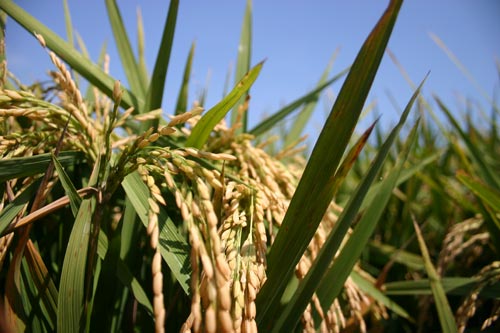
LSU AgCenter introduces online rice insect guide
New online program developed by the LSU AgCenter.Program originated from a conversation with Evangeline Parish farmer Richard Fontenot.Anyone with access to the Internet through a smart phone can get to the guide in the field and through process of elimination, click on a list of symptoms and narrow down the pest and suggested treatments.Rice producers in states outside Louisiana will refer to the site, but pesticide recommendations on the website may not have been approved by the U.S. Environmental Protection Agency for use on rice in other states.
January 4, 2011

Solving the whodunit mystery of insect damage in a rice crop will be easier with a new online program developed by the LSU AgCenter.
Using the process is as easy as playing the board game “Clue” because it uses a simple process of elimination, according to LSU AgCenter experts. But instead of guessing if the perpetrator was Col. Mustard armed with a lead pipe, the usual suspects will be arthropods (insects and mites) such as the rice water weevil, billbug, chinch bug or spider mites.
The program originated from a conversation with Evangeline Parish farmer Richard Fontenot, said LSU AgCenter entomologist Natalie Hummel. “The whole project was his idea.”
Anyone with access to the Internet through a smart phone can get to the guide in the field and through process of elimination, click on a list of symptoms and narrow down the pest and suggested treatments.
“It doesn’t require you to be an entomologist to use it,” Hummel said.
The website starts by asking users to identify the location of visible damage, then lists descriptions of different types of damage with photographs to illustrate the feeding signs so the user can identify the likely culprit.
For example, feeding on the lower part of the plant brings the user to the options of feeding signs on the leaf blade or another part of the plant. If the feeding is on the surface of the leaf blade, the next step is to choose between the first option of feeding on “narrow strips of leaf material removed between veins” or “other type of feeding damage or leaf dehydration.”
The first option would identify the suspect as Public Enemy No. 1 in rice farming, the notorious rice water weevil, or the lesser-known rice leaf miner. The second choice, “Other type of feeding damage or leaf dehydration,” asks the user to further identify the damage, choosing between broken leaf tips, which could be caused by the Southern green stink bug, or dehydrated leaf tips, which is probably the work of aphids.
“At the final step, you will see a picture of the arthropod and some information about scouting and management,” Hummel said. The guide also has links to videos that show how scouting should be done for rice water weevils and colaspis, a small beetle.
Hummel said rice producers in states outside Louisiana will refer to the site because Louisiana is home to all of the rice insect pests. But she said pesticide recommendations on the website may not have been approved by the U.S. Environmental Protection Agency for use on rice in other states.
This project demonstrates how the LSU AgCenter meets the needs of farmers, said Paul Coreil, LSU AgCenter vice chancellor for Extension.
“The online guide will aid farmers who need quick answers to their pest problems,” Coreil said. “With our increasingly tighter budget, we’ve got to figure out cost-efficient ways of providing help, and this is one way of accomplishing that.”
The site address is: http://www.lsuagcenter.com/ricepestguide.
You May Also Like



